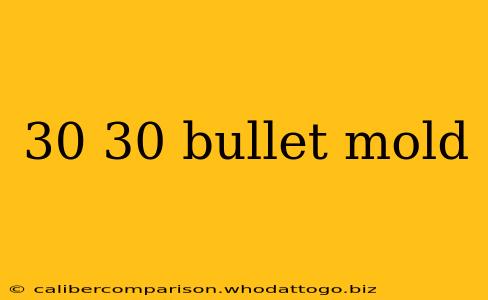The .30-30 Winchester, a legendary cartridge synonymous with American hunting and folklore, continues to captivate shooters. For those who appreciate the art of reloading, crafting your own .30-30 ammunition using a 30-30 bullet mold offers a rewarding and cost-effective approach. This guide delves into the world of 30-30 bullet molds, exploring various types, considerations for selection, and essential techniques for successful casting.
Understanding 30-30 Bullet Molds: Types and Features
30-30 bullet molds are available in a variety of designs, each catering to different preferences and reloading needs. Key features to consider include:
-
Material: Most molds are constructed from hardened steel or aluminum. Steel molds generally offer superior durability and longevity, while aluminum molds are often lighter and less expensive.
-
Cavity Count: Molds can have one, two, or even more cavities. A two-cavity mold, for example, doubles your casting output per pour, significantly increasing efficiency.
-
Bullet Style: You'll find molds producing various bullet styles for the 30-30, including:
- Round Nose: A classic design, offering good accuracy and penetration. Ideal for general hunting purposes.
- Round Nose Flat Point (RNFP): A versatile option balancing accuracy, penetration, and expansion.
- Flat Nose: Provides excellent accuracy at shorter ranges and is suitable for plinking or hunting smaller game.
- Spitzer: This pointed bullet style offers superior ballistic performance at longer distances but may require careful seating depth adjustments.
-
Handle Type: Molds commonly feature either a simple hand-held design or a more ergonomic handle for easier operation.
Choosing the Right 30-30 Bullet Mold: Factors to Consider
Selecting the appropriate 30-30 bullet mold hinges on several key factors:
-
Your Reloading Goals: Are you primarily focused on hunting, target shooting, or plinking? This will dictate the optimal bullet style and weight.
-
Budget: Steel molds generally command a higher price tag than aluminum molds. Determine your budget beforehand to narrow your options.
-
Experience Level: Beginners might find single-cavity molds easier to manage, while experienced reloaders might prefer the efficiency of multi-cavity designs.
-
Accuracy Requirements: If precision is paramount, prioritize a well-regarded mold manufacturer with a reputation for producing consistent and accurate bullets.
Essential Techniques for Successful 30-30 Bullet Casting
Successful bullet casting using your 30-30 bullet mold requires attention to detail and proper technique:
-
Alloy Selection: Using a suitable alloy is critical for obtaining bullets with the desired hardness and performance characteristics. Experimentation might be necessary to find the ideal alloy for your specific mold and intended use.
-
Temperature Control: Maintain a consistent metal temperature throughout the casting process to ensure consistent bullet weights and dimensions.
-
Proper Lubrication: Lubricating your mold effectively prevents sticking and ensures smooth bullet release. Several commercially available bullet lubricants are available, each with its own advantages and disadvantages.
-
Bullet Sizing: After casting, sizing your bullets to the correct diameter is crucial for proper chambering and feeding. An appropriate bullet sizer is required for this step.
Safety Precautions: Prioritizing Safety in Reloading
Reloading ammunition, including casting bullets, inherently involves risks. Always prioritize safety by adhering to the following:
- Proper Ventilation: Casting bullets generates fumes; ensure adequate ventilation to avoid inhaling harmful gases.
- Eye Protection: Always wear safety glasses to protect your eyes from molten metal splashes.
- Heat Resistant Gloves: Use heat-resistant gloves to prevent burns when handling molten metal.
- Fire Safety: Keep a fire extinguisher readily available.
Following these guidelines and utilizing a reliable 30-30 bullet mold will allow you to enjoy the rewarding experience of crafting your own ammunition, tailoring your loads to your specific needs. Remember to consult relevant reloading manuals and always practice safe reloading techniques.

